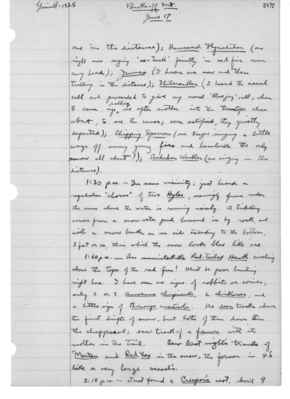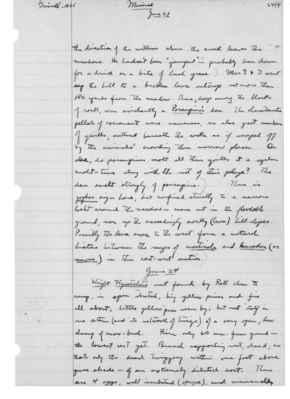Pages That Mention Thomomys monticola
1925: Joseph Grinnell's field notes
S2 Page 17
Collector: Grinnell - 1925 Location: Lassen Section (Brokeoff Mt.) Date: June 17, 1925 Page Number: 2472
one in the distance); Hammond Flycatcher (one right now saying "see-Tuck" faintly in red fir over my head); Junco (I hear one now and then trilling in the distance); Nutcracker (I heard the nasal call and proceeded to give my usual "bluejay" call, when 5 came up, calling, one after another into the treetops close about, to see the cause; soon satisfied, they quietly departed); Chipping Sparrow (one keeps singing a little way off away young firs and hemlocks the only snow all about!); Audubon Warbler (one singing in the distance). 1:30 p.m. - In same vicinity; just heard a regulation "chorus" of two Hylas, seemingly from under the snow where the water is running noisily. A tributary comes from a snow-water pond hemmed in by rock, and with a snow bank on one side extending to the bottom, 3 feet or so, thru which the snow looks blue like ice. 1:50 p.m. - An unmistakable Red-Tailed Hawk circling above the tops of the red firs! Must be poor hunting right here. I have seen no signs of rabbits or conies; only 2 or 3 Amoenus Chipmunk, 2 chickadees, and a little sign of Thomomys monticola. No deer tracks above the first drifts of snow, but lots of them down thru the chaparral; saw track of a fawn with its mother in the trail. Saw last night's tracks of Marten and Red Fox in the snow, the former in 4's like a very large weasel's. 2:15 p.m. - Just found a Creeper's nest, about 9
S2 Page 25
Author: Grinnell-1925 Location: Mineral, 4800 ft. Date: June 19 Page Number: 2480
Later: found the Traill Flycatcher's nest some 7 feet up in a crotch of slender willow stem in the midst of an isolated willow clump in the meadow - just in process of construction. In a tract of old lodge pole pines a little farther along, a crowd of birds was distraught over something, tho I failed to find what the threatening danger was. The crowd included: Juncos, a pair of Robins, a Lincoln Sparrow, a Pigmy Nuthatch (the first I have seen in the Lassen "section"), a Hammond (or Wright) Flycatcher, several Chipping Sparrows, and a pair of Audubon Warblers. Nearby was a (female) White-headed Woodpecker.
As to mammals: winter earthcores of Thomomys monticola occur in places where the ground is well-drained at the sides of meadows but not out in them. The common chipmunk is Eutamias amoenus, about logs overgrown with snowbushes, but they are very quiet now; two visit camp, but so far are shy. A (female) Eutamias senex was trapped in a neighbor's camp yesterday morning at 5 o'clock. Last evening just before sundown, Dixon shot an old male jack-rabbit (Lepus c. californicus) in a tract of sparse snowbush. Mrs. G. has seen another partly grown one in the same vicinity. This must be the extreme easternmost limit of this subspecies in the "section". Also, Mrs. G. and Dixon have both seen individuals of the snow-shoe rabbit (Lepus w. klamathensis).
S2 Page 40
Collector: Grinnell - 1925 Location: Mineral Date: June 23-24 Page Number: 2494
the direction of the willows where the creek leaves the meadows. He hadn't been "jumped" - probably been down for a drink or a bit of lush grass. Mrs. G. & I went up the hill to a broken lava outcrop not more than 150 yards from the meadow. There, deep among the blocks of rock, was evidently a Porcupine's den. The characteristic pellets of excrement were numerous, as also great numbers of quills, scattered beneath the rocks as if scraped off by the animals' crowding the narrow place. Or else, do porcupines molt all their quills at a regular molt-time along with the rest of their pelage? The den smelt strongly of porcupine. There is gopher sign here, but confined strictly to a narrow belt around the meadow - none out in the floodable ground, nor up in the exceedingly rocky (lava) hill-slopes. Possible the lava areas to the west form a natural hiatus between the ranges of monticola and leucodon (or navus) in this east-west section.
June 24 Wright Flycatcher's nest found by Rett close to camp, in open stretch, big yellow pines and firs all about; little yellow pines near by; but nest itself in one stem (and its network of twigs) of a very open, low clump of snow-bush. Rim only 6/0 mm. from ground the lowest nest yet. Branch supporting nest, dead; so that only the dead twiggery within one foot above gives shade - of an extremely diluted sort. There are 4 eggs, well incubated (opaque), and unusually
S2 Page 81
Collector: Grinnell - 1925 Location: Broke-off Mt. Date: July 27 Page Number: 2533
foliage which the breeze kept in disconcerting agitation); Cassin Purple Finch (2 or more, distantly heard and seen in tops of hemlocks); Sierra Grouse (2, as above); Hammond Flycatcher (2 immatures, separately, seen closely in hemlocks at 8000 to 9000 ft.); Junco (2, in hemlocks).*
In the red-fir belt (Canadian), 8000 ft., about, down to 7000 ft., where we left the machine, noted: Deer (doe and fawn at edge of alder thicket); Callospermophilus (2 or more); Thomomys monticola (sign common); Fox Sparrow (one immature near patch of heather along little stream at 8000 ft., and others heard in alder patches); Juncos (commonest bird, one [male symbol] singing at tip of lofty red fir - many full-grown young in scattering troupes); Evening Grosbeak (one family of 5 or so alighted on dead lower branches of a fir and notes of others were heard now and then); Solitaire (one flushed from ground); Siskin (notes of 2 or 3 heard overhead); Blue-fronted Jay (heard several times); Cassin Vireo (2 immatures closely seen in a jungle of white alders); Hammond Flycatcher (weak call notes heard often, and one bird seen, 30 feet or so up in densely shaded branchwork of fir); Wood Pewee (pair at 7000 ft.); Pileated Warbler (song of one heard from alders); Robin (a pair at a little ^moraine lake in the fir woods was noisily concerned at our presence); Audubon Warbler (a family, male singing, in trees at this same lake); Canada Nuthatch (notes heard in the distance).
S2 Page 84
Collector: Grinnell - 1925 Location: Mineral Date: July 29 Page Number: 2535
We were seated on a log, when a Eutamias senex ran across some open round within 40 feet of us and disappeared into another large log; in the animal's mouth was a baby chipmunk, about 1/4 grown it looked, belly up and tail curled over the mother's head. As I was walking along the trail, I saw some small animal scurry along the side of a rotten log and across the open for 2 feet disappearing under a slab of rotten wood. I lifted up the latter, expecting a lizard (tho [sic] no lizard has been seen up Viola Trail), when out popped a Shrew (see beyond) which Mrs. G. pounced upon with success. Here was a case of a shrew venturing out into the open close to noon of a brilliantly sunshiny day; it was a suckling [female symbol]. The rotten wood and earth beneath the log and slab was quite damp. No nest was discovered.
6295 Sorex m. mariposa (?) [female symbol] suckling 6.8g. 120x51x14.5x4. Caught under slab (as above) on ground in Transition zone (Dry woods of yellow pine, white fir and incense cedar) on ridge at 550 ft., 2 mi. NE Mineral.
6296 Sorex v. amoenus (?) [male symbol] 4.7g 108x44x11.5x3. Caught in oat-baited mouse trap (scented) set in rank grass under willows in bog near camp.
6297 Thomomys monticola [male symbol] 92g. 205x66x26x8.
6298 [Thomomys] [monticola] [male symbol] ju. 51g. 170x55x25x7.
Both these gophers caught near camp, in traps, in dryish ground between ceanothus thickets.




